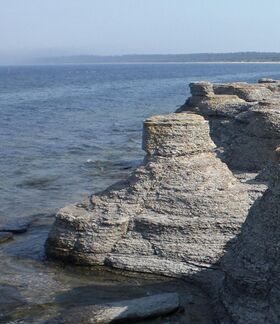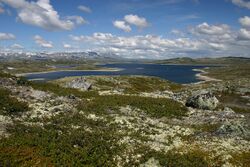Earth:Sub-Cambrian peneplain
The sub-Cambrian peneplain is an ancient, extremely flat, erosion surface (peneplain) that has been exhumed and exposed by erosion from under Cambrian strata over large swathes of Fennoscandia. Eastward, where this peneplain dips below Cambrian and other Lower Paleozoic cover rocks. The exposed parts of this peneplain are extraordinarily flat with relief of less than 20 m. The overlying cover rocks demonstrate that the peneplain was flooded by shallow seas during the Early Paleozoic.[1] Being the oldest identifiable peneplain in its area the Sub-Cambrian peneplain qualifies as a primary peneplain.[2][3]
The surface was first identified by Arvid Högbom in a 1910 publication, with Sten Rudberg publishing the first extensive map in 1954. This mapping has been improved upon by Karna Lidmar-Bergström since the 1980s.[4][5]
Extent
The Sub-Cambrian peneplain extends as an almost continuous belt along the eastern coast of Sweden for some 700 km from north to south.[6] Near Stockholm and Hudiksvall the peneplain is densely dissected by joint valleys and at the High Coast is the Sub-Cambrian peneplain is both highly uplifted and eroded.[7][8][9] More inland the peneplain can be traced at the crestal region of the South Swedish Dome where it is dissected by joint valleys.[7][8] The Sub-Cambrian peneplain in the crestal region of the South Swedish Dome is the highest step in a piedmonttreppen system seen in Småland.[5] In southern Sweden the peneplain surfaces tilt away from the crest of South Swedish Dome, to the northwest in Västergötland, to the northeast in Östergötland and to the east in eastern Småland.[2] At this last region the sub-Cambrian peneplain is truncated to the west by a well defined and prominent scarp that separates it from the South Småland peneplain to the west.[5][upper-alpha 1]
In the Central Swedish lowland the peneplain extends further west being 450 km wide from west to east.[6] Immediately east and south of lake Vänern the peneplain tilts west and north respectively. This is reflected in that the southeastern part of the lake is very shallow but gets progressively deeper towards the northwest.[11] In Bohuslän, at the northern end of the Swedish West Coast, there is some uncertainty over whether the hilltops are remnants of the peneplain.[12] A similar situation occurs in central Halland.[5] Further west, parts of the Paleic surface in Norway have been interpreted to be part of the peneplain that has been tectonically uplifted and is apparently disrupted by NNE-SSW trending faults. Near the 1,100 m high Hardangervidda plateau in Norway is the Sub-Cambrian peneplain has been uplifted at least thousand meters,[13] albeit Hardangervidda itself is part of a much younger peneplain formed in the Miocene epoch.[14]
At Stöttingfjället in northern Sweden the peneplain occur, as result of tectonic uplift, at about 650 meters giving origin to a series of water gaps including those of Ångermanälven, Indalsälven and Ljusnan.[9]
In northwestern Finland the Ostrobothnian Plain is a continuation of the peneplain.[15] To the east the Sub-Cambrian peneplain continues as an unconformity beneath the East European Platform.[6][16][upper-alpha 2] On a grand-scale the peneplain is not completely flat as it has been deformed. This deformation is an isostatic response to erosion and the load of Phanerozoic sediments that rests above much of the peneplain.[16] The peneplain is characterized by a general lack of inselbergs.[2][6] One exception to this is the island Blå Jungfrun in the Baltic Sea which is an ancient inselberg formed in Precambrian time and buried in sandstone after its formation. Blå Jungfrun remained buried until erosion of the East European Platform freed it in geologically recent times.[17]
Origin
Interpretations of Jotnian sandstone imply that much of the Baltic Shield have had faint relief since the Mesoproterozoic,[18][19] but no exhumed peneplain from this period has been preserved.[7][upper-alpha 3] The low relief terrain on which the Jotnian sandstone deposited was disturbed by the Sveconorwegian orogeny in western Sweden about 1,000 million years ago and then begun to erode again into a terrain of subdued relief.[5]
The peneplain formed after 600 million years ago but prior to the Cambrian transgression. The basement rocks forming the peneplain surface were exhumed from depths were the temperature was in excess of 100 °C prior to the formation of peneplain.[8] Karna Lidmar-Bergström and co-workers assume the peneplain formed through a cycle of erosion with a preceding brief valley phase and that it grades down to a former sea level.[1][6] Due to the absence of land vegetation in Precambrian times sheet wash is thought to have been an important process of erosion leading to the formation of extensive pediments. Sheet wash would also have hindered the formation of deep weathering profiles. Indeed, at the places the substrate of the Sub-Cambrian peneplain is kaolinized it never exceeds a few meters in depth.[12]
Sedimentary rock cover

The flatness of the peneplain meant that during the Cambrian transgression very large areas were swiftly flooded forming large and shallow inland seas in changing configurations. The new relief formed on top of Cambrian sediments smoothed out irregularities in the peneplain.[20] Early Cambrian sandstones overlying the peneplain in southern Norway, Scania and Bornholm have likely never been recycled. This means the parent rocks of the sandstone were eroded and the sediment strongly reworked and weathered reaching sedimentary maturity with no other in-between step or hiatus.[21] The source areas for these sandstones are local rocks from the Transscandinavian Igneous Belt or the Sveconorwegian and Gothian orogens.[21]
See also
- Baltic Klint
- Muddus plains
- Norrland terrain
Notes
References
- ↑ 1.0 1.1 Lidmar-Bergström, Karna; Bonow, Johan M.; Japsen, Peter (2013). "Stratigraphic Landscape Analysis and geomorphological paradigms: Scandinavia as an example of Phanerozoic uplift and subsidence". Global and Planetary Change 100: 153–171. doi:10.1016/j.gloplacha.2012.10.015.
- ↑ 2.0 2.1 2.2 Lidmar-Bergström (1988). "Denudation surfaces of a shield area in southern Sweden". Geografiska Annaler 70 A (4): 337–350. doi:10.1080/04353676.1988.11880265.
- ↑ Fairbridge, Rhodes W.; Finkl Jr., Charles W. (1980). "Cratonic erosion unconformities and peneplains". The Journal of Geology 88 (1): 69–86. doi:10.1086/628474.
- ↑ Lidmar-Bergströrm, Karna (1996). "Long term morphotectonic evolution in Sweden". Geomorphology 16: 33–59. doi:10.1016/0169-555X(95)00083-H.
- ↑ 5.0 5.1 5.2 5.3 5.4 Lidmar-Bergström, Karna; Olvmo, Mats; Bonow, Johan M. (2017). "The South Swedish Dome: a key structure for identification of peneplains and conclusions on Phanerozoic tectonics of an ancient shield". GFF 139 (4): 244–259. doi:10.1080/11035897.2017.1364293. http://urn.kb.se/resolve?urn=urn:nbn:se:miun:diva-31508.
- ↑ 6.0 6.1 6.2 6.3 6.4 6.5 Green, Paul F.; Lidmar-Bergström, Karna; Japsen, Peter; Bonow, Johan M.; Chalmers, James A. (2013). "Stratigraphic landscape analysis, thermochronology and the episodic development of elevated, passive continental margins". Geological Survey of Denmark and Greenland Bulletin 30: 18. doi:10.34194/geusb.v30.4673. http://www.geus.dk/publications/bull/nr30/index-uk.htm. Retrieved 30 April 2015.
- ↑ 7.0 7.1 7.2 7.3 Lidmar-Bergström, Karna (1995). "Relief and saprolites through time on the Baltic Shield". Geomorphology 12: 45–61. doi:10.1016/0169-555X(94)00076-4.
- ↑ 8.0 8.1 8.2 Japsen, Peter; Green, Paul F.; Bonow, Johan M.; Erlström, Mikael (2016). "Episodic burial and exhumation of the southern Baltic Shield: Epeirogenic uplifts during and after break-up of Pangaea". Gondwana Research 35: 357–377. doi:10.1016/j.gr.2015.06.005.
- ↑ 9.0 9.1 Lidmar-Bergström, Karna; Olvmo, Mats (2015). Plains, steps, hilly relief and valleys in northern Sweden – review, interpretations and implications for conclusions on Phanerozoic tectonics (Report). Geological Survey of Sweden. p. 12. http://resource.sgu.se/produkter/c/c838-rapport.pdf. Retrieved June 29, 2016.
- ↑ Lidmar-Bergström, Karna. "Sydsvenska höglandet" (in sv). Cydonia Development. https://www.ne.se/uppslagsverk/encyklopedi/l%C3%A5ng/sydsvenska-h%C3%B6glandet.
- ↑ Hall, Adrian M.; Krabbendam, Maarten; van Boeckel, Mikis; Hättestrand, Clas; Ebert, Karin; Heyman, Jakob (2019-12-01). The sub-Cambrian unconformity in Västergötland, Sweden: Reference surface for Pleistocene glacial erosion of basement (Report). Swedish Nuclear Fuel and Wast Management Co. https://www.skb.com/publication/2495096/TR-19-21.pdf. Retrieved 2020-11-26.
- ↑ 12.0 12.1 Lidmar-Bergström, Karna (1993). "Denudation surfaces and tectonics in the southernmost part of the Baltic Shield". Precambrian Research 64 (1–4): 337–345. doi:10.1016/0301-9268(93)90086-H.
- ↑ Jarsve, Erlend M.; Krøgli, Svein Olav; Etzelmüller, Bernd; Gabrielsen, Roy H. (2014). "Automatic identification of topographic surfaces related to the sub-Cambrian peneplain (SCP) in southern Norway—Surface generation algorithms and implications". Geomorphology 211: 89–99. doi:10.1016/j.geomorph.2013.12.032. http://urn.nb.no/URN:NBN:no-46208.
- ↑ Japsen, Peter; Green, Paul F.; Chalmers, James A.; Bonow, Johan M. (17 May 2018). "Mountains of southernmost Norway: uplifted Miocene peneplains and re-exposed Mesozoic surfaces". Journal of the Geological Society 175 (5): jgs2017–157. doi:10.1144/jgs2017-157. http://jgs.lyellcollection.org/content/early/2018/04/30/jgs2017-157.
- ↑ Behrens, Sven; Lundqvist, Thomas. "Finland: Terrängformer och berggrund" (in sv). Cydonia Development. https://www.ne.se/uppslagsverk/encyklopedi/l%C3%A5ng/finland?i_h_word=%25C3%25B6sterland.
- ↑ 16.0 16.1 Amantov, Aleksey; Feldskaar, Willy (March 26, 2015). "Det subkambriske peneplanet i Baltika" (in no). http://www.geoforskning.no/nyheter/grunnforskning/929-det-subkambriske-peneplanet-i-baltika.
- ↑ Lidmar-Bergström, Karna. "Inselberg" (in sv). Cydonia Development. http://www.ne.se/uppslagsverk/encyklopedi/l%C3%A5ng/inselberg.
- ↑ Lundmark, Anders Mattias; Lamminen, Jarkko (2016). "The provenance and setting of the Mesoproterozoic Dala Sandstone, western Sweden, and paleogeographic implications for southwestern Fennoscandia". Precambrian Research 275: 197–208. doi:10.1016/j.precamres.2016.01.003.
- ↑ Bingen, Bernard; Andersson, Jenny; Söderlund, Ulf; Möller, Charlotte (2008). "The Mesoproterozoic in the Nordic countries". Episodes 31 (1): 29–34. doi:10.18814/epiiugs/2008/v31i1/005.
- ↑ Nielsen, Arne Thorshøj; Schovsbo, Niels Hemmingsen (2011). "The Lower Cambrian of Scandinavia: Depositional environment, sequence stratigraphy and palaeogeography". Earth-Science Reviews 107 (3–4): 207–310. doi:10.1016/j.earscirev.2010.12.004.
- ↑ 21.0 21.1 Lorentzen, Sanne; Augustsson, Carita; Nystuen, Johan P.; Bernd, Jasper; Jahren, Jens; Schovsbo, Niels H. (2018). "Provenance and sedimentary processes controlling the formation of lower Cambrian quartz arenite along the southwestern margin of Baltica". Sedimentary Geology 375: 203–217. doi:10.1016/j.sedgeo.2017.08.008. https://www.researchgate.net/publication/319495455.
 |




